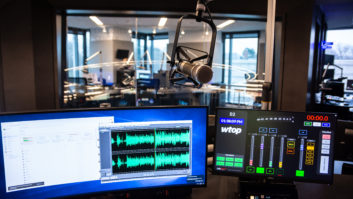(click thumbnail)Fig. 1: The station took several smart steps to prepare this cable entry.Figure 1 begs the question, “Will lightning run backward?” It’s always a good idea to add a cable ground kit, as shown in the photo, but the best protection occurs when the ground wire is not looped and runs straight to the ground strap.
The second coax belongs to a tenant, and it was their choice not to ground it. I’m not sure I would want ungrounded line entering the transmitter building.
This point should be added to any tower lease: lines will be installed and grounded as recommended by the coax manufacturer.
I’m a big proponent of sealing your building, and you can imagine that this station got high points by plugging the coax entry point with expanding foam. I like something else, too: they used the outer jacket of a spare piece of line to encase the coax. You can see a 3-inch piece of jacket protruding from the wall.
Should the line ever need to be replaced, the cable will slip in and out easily. If you’ve ever worked with this expanding foam, you know it’s sturdy stuff. So save yourself the headache and use some kind of sheath to make removal easier.

. . .
In this holiday season, thoughts of doing something nice for the staff may come to mind. After all, keeping your staff happy definitely is part of the politics of running the technical side of a radio station!
(click thumbnail)Fig. 2: Hinged security panels can keep twiddlers away.
Tim Parker with Bonneville’s WWZZ(FM) in Washington added a wall panel switch to control the station’s overhead speakers. In the Z’s case, the speakers can be set to monitor the station audio and break away for paging (labeled “Page/The Z”), or selected for “Page Only,” should a quieter environment be required.
This is a good job for your assistant, and it’s an ideal solution for conference rooms or lunchrooms. Another approach is to provide a multi-position selector switch, so that any station in a cluster can be fed through the PA system.
I won’t go into the elaborate system one GM wanted, in which the music-on-hold was switched from the easy-listening station in the morning and afternoon hours on Monday, Wednesday and Friday to the country station in the middle of the day. On Tuesday and Thursday, the rock station played all day.
We were ready build the circuit, but I think the price scared him away.

. . .
While we’re talking about doing nice things, how about something nice for yourself?
I’m talking about security panels, like the ones shown in Figure 2. The hinged panel permits quick access, but provides a nice seal to keep eager fingers out.
Middle Atlantic and Orban provide security panels. Contact your distributor for more information or head to the Web sites.
. . .
How is your tower grounding these days? If you’ve taken over a new site and find clamped grounds, consider remaking the connection with Cadwelding.
Erico Inc., which developed this trademarked exothermic welding process in 1938, makes a one-shot Cadweld system, sold at electric supply stores. The system is priced reasonably so you can get the benefits of Cadwelding at a price that won’t break the bank and without a lot of expensive equipment.
. . .
Perhaps one of the most frustrating and costly tower ventures is replacing tower light wiring on older towers.
Michael Barnes, engineer at the World Radio Network in McAllen, Texas, encountered chafed wires inside the conduit going up the tower, most likely due to years of vibration in the wind. Conduit joints also were loose, and in some cases, the wind would flex the tower to the point that you can hear some serious sparking inside the conduit.
You know what happens next: the breaker trips. To make matters worse, the 50-foot horizontal run from the building to the tower was constructed using white water-pipe fittings.
Michael also found an unusual fitting on the base of the lowest junction box, a foot-long stub with a threaded coupling. Screwed onto the coupling is a garden-hose connector with a screen over the opening. A condensation drain, and as pointed out by Tom Osenkowsky, CPBE from New England, a feature necessary over long runs of conduit.
Keep in mind that the temperature inside the conduit can vary considerably over the 1,000-foot length of the run. No drainage? The worst-case scenario, flooded conduit, could be the result.
Faced with aging tower light wiring? See if you can extinguish the lights. Especially in the case of multi-tower AM DAs, you may be able to get a waiver to extinguish some or all of the lights.
Submissions for this column are encouraged, and qualify for SBE recertification credit. Fax your submission to (703) 323-8044, or send e-mail to[email protected]












